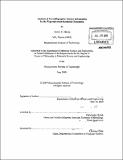Analysis of crystallographic texture information by the hyperspherical harmonic expansion
Author(s)
Mason, Jeremy K. (Jeremy Kyle)
DownloadFull printable version (35.14Mb)
Other Contributors
Massachusetts Institute of Technology. Dept. of Materials Science and Engineering.
Advisor
Christopher Schuh.
Terms of use
Metadata
Show full item recordAbstract
The field of texture analysis is fundamentally concerned with measuring and analyzing the distribution of crystalline orientations in a given polycrystalline material. Traditionally, the orientation distribution function describing crystallographic orientation information is written as a linear combination of the generalized spherical harmonics. Since the use of generalized spherical harmonics requires that orientations be described by sets of Euler angles, the field of texture analysis suffers from the inherent limitations of Euler angles. These include difficulty of presentation and interpretation, discontinuous changes in the description of a changing orientation, and singularities in many equations of Euler angles. An alternative expansion of the orientation distribution function as a linear combination of the hyperspherical harmonics is therefore proposed, with the advantage that this expansion allows rotations to be described by angles that directly relate to the axis and angle of a rotation. Apart from the straightforward and intuitive presentation of orientation statistics that this allows, the utility of the hyperspherical harmonic expansion rests on the fact that the orientation distribution function inherits the useful mathematical properties of the hyperspherical harmonics. The relationship of the hyperspherical harmonics to the three- and four-dimensional rotation groups is investigated, and expressions for the matrix elements of the irreducible representatives of these rotation groups as linear combinations of the hyperspherical harmonics are found. (cont.) These expressions allow an addition formula for the hyperspherical harmonics to be derived, and provide the means to write a simple conversion between the generalized spherical harmonic and hyperspherical harmonic expansions. This allows results derived via the hyperspherical harmonic expansion to be related to the texture analysis literature. Furthermore, a procedure for calculating the symmetrized hyperspherical harmonics consistent with crystal and sample symmetries is indicated, and used to perform the expansion of an orientation distribution function significantly more efficiently. The capability of the hyperspherical harmonic expansion to provide results not traditionally accessible is demonstrated by the generalization of the Mackenzie distribution to arbitrary textures. Finally, further areas where the application of the hyperspherical harmonic expansion is expected to advance the field of texture analysis are discussed.
Description
Thesis (Ph. D.)--Massachusetts Institute of Technology, Dept. of Materials Science and Engineering, 2009. Cataloged from PDF version of thesis. Includes bibliographical references (p. 223-230).
Date issued
2009Department
Massachusetts Institute of Technology. Department of Materials Science and EngineeringPublisher
Massachusetts Institute of Technology
Keywords
Materials Science and Engineering.